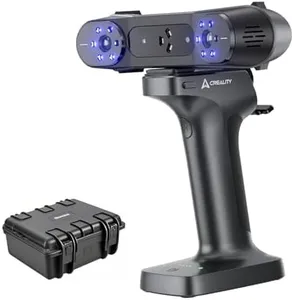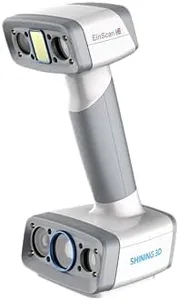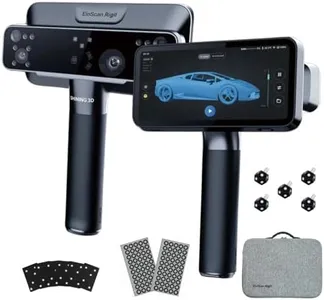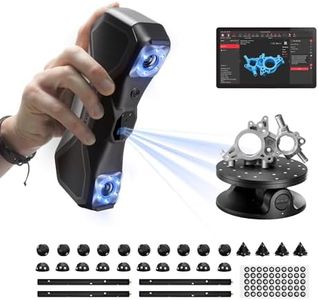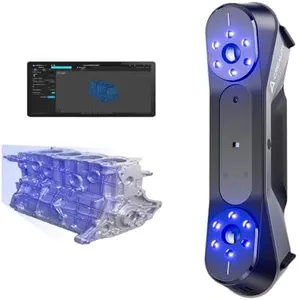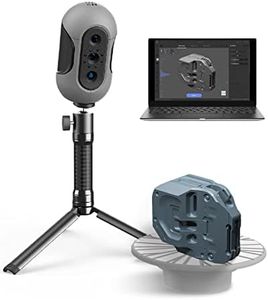10 Best 3D Scanners 2025 in the United States
Our technology thoroughly searches through the online shopping world, reviewing hundreds of sites. We then process and analyze this information, updating in real-time to bring you the latest top-rated products. This way, you always get the best and most current options available.

Our Top Picks
Winner
EinScan Pro HD Handheld 3D Scanner with Industrial Pack, Color Pack, Solid Edge Shining3D CAD Software, 0.2mm Resolution, 0.04mm Accuracy for Reverse Engineering, 3D Modeling, Art, Design, Healthcare
The EinScan Pro HD Handheld 3D Scanner is a versatile tool that suits users needing detailed and accurate 3D scans for applications like reverse engineering, art, and healthcare. It offers impressive resolution with a minimum point distance of 0.2mm, which means it can capture fine details without needing extra markers. Accuracy is another strong point, reaching up to 0.04mm in fixed scanning mode, ensuring high-quality 3D models. The scanner covers a wide range of object sizes—from very small (around 1 inch) to quite large (up to 10 feet)—making it flexible for various projects.
The inclusion of color scanning adds value by capturing full-color textures along with shapes, which helps in creating more realistic models. The bundled Industrial Pack with tripod and turntable adds stability and convenience for scanning different objects, while the Solid Edge CAD software enhances compatibility for design and engineering workflows. The scanner weighs about 2.36 pounds and measures around 6 x 10 inches, so it remains fairly portable but might not be the lightest option for all-day handheld use. Although specific scan speed details are not emphasized, the product highlights efficiency through texture alignment without extra preparation.
This device is well suited for users who need a dependable, high-detail scanner with strong software support and multi-functionality. New users, however, may experience a learning curve when working with the advanced features and setup included in the Industrial Pack.
Creality 3D Scanner Raptor Pro and Scan Bridge Wireless Scanning, 3D Scanner for 3D Printing, High Precision 0.02mm, 60FPS Scanning Speed, 22+7 Blue Laser Lines
Most important from
8 reviews
The Creality Raptor Pro 3D Scanner is designed for users who need high precision and fast scanning, making it a solid choice for 3D printing enthusiasts and professionals alike. It offers ultra-high accuracy with up to 0.02mm precision, which means it can capture fine details very well. The scanning speed is impressive at 60 frames per second, allowing for quick data capture without long waiting times. The wide scanning range supports objects from very small (5mm) to quite large (up to 2000mm), which gives flexibility for various projects.
Portability might be average since the package is a bit bulky at over 12 pounds, but the wireless scanning feature adds convenience by reducing cable clutter and improving ease of movement during use. The scanner also supports full-color mapping, which helps create realistic textures on digital models, and uses marker-based alignment to simplify the process of combining multiple scans into one complete image. The included Scan Bridge should make setup and operation straightforward for most users.
This scanner successfully balances strong technical performance with user-friendly features, making it a versatile tool. However, those needing a lightweight, ultra-compact scanner might find this model less ideal.
Most important from
8 reviews
EinScan H2 Handheld 3D Scanner Pro- High Texture Resolution 3D Scanner for 3D Printing with Built-in Color Camera, Handheld Infrared Light for IR Mode, Shining Version CAD Software Compatible
Most important from
7 reviews
The EinScan H2 Scanner is a versatile handheld 3D scanner tailored for professional use in 3D printing and modeling. Its standout feature is the high-resolution 5MP texture camera, which captures photorealistic textures, making it ideal for detailed and accurate models. The hybrid LED and infrared light source enables the scanner to work effectively on various surfaces and in different lighting conditions, enhancing its usability in diverse environments.
This is particularly beneficial for scanning dark objects and human bodies, offering up to 0.05 mm accuracy and 0.2 mm resolution for intricate detail capture. Additionally, the use of invisible infrared light ensures safe and comfortable scanning, especially for human subjects, making it suitable for projects requiring lifelike models. The scanner is lightweight, weighing 703 grams, and comes with essential software like SolidEdge CAD and ExScan H, along with a durable carrying case, ensuring it's a complete package for professionals.
The scanner’s reliance on USB connectivity may limit its flexibility for some users. Furthermore, the 60 watts power requirement might be on the higher side for those looking for energy-efficient devices. These minor drawbacks aside, the EinScan H2 stands out as a robust tool for professionals needing high precision and detail in their 3D scanning tasks.

